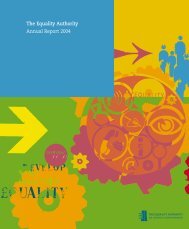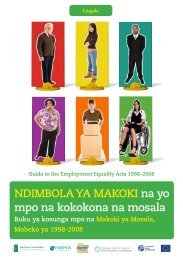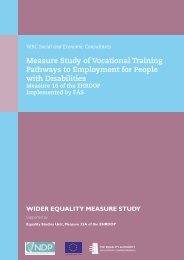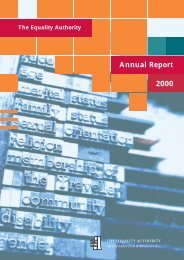Equality and Diversity - Building a Culture of ... - Equality Authority
Equality and Diversity - Building a Culture of ... - Equality Authority
Equality and Diversity - Building a Culture of ... - Equality Authority
Create successful ePaper yourself
Turn your PDF publications into a flip-book with our unique Google optimized e-Paper software.
Lessons 15<br />
Exploring <strong>Equality</strong><br />
what does it mean to you?<br />
B. What does <strong>Equality</strong> Mean?<br />
Learning Intentions<br />
Students will explore their<br />
underst<strong>and</strong>ing <strong>of</strong> equality<br />
Students will consider the<br />
limitations or potential issues<br />
connected with common<br />
descriptions <strong>of</strong> equality<br />
Resources<br />
<br />
<br />
Selection <strong>of</strong> chocolates<br />
Activity one<br />
Distribute the chocolates to a number <strong>of</strong> students based on a<br />
specific trait or characteristic, for example, gender; students<br />
who are wearing earrings; students with long hair; students<br />
wearing glasses; students sitting in a certain place in the class.<br />
Ask the students to guess why some <strong>of</strong> them got a<br />
chocolate <strong>and</strong> others didn’t. The students may start to<br />
protest that it’s not fair that some got one <strong>and</strong> not others,<br />
or may make accusations that this was discrimination.<br />
Explain that this was just a way <strong>of</strong> prompting them to start<br />
thinking about equality <strong>and</strong> what it means <strong>and</strong> that the<br />
next few lessons will explore the concept <strong>of</strong> equality.<br />
Equal or Not? – 1 copy for each<br />
pair <strong>of</strong> students<br />
Activity two<br />
Method 1<br />
One set <strong>of</strong> the <strong>Equality</strong> Means<br />
statements – each statement<br />
printed on A4 sheets<br />
Sets <strong>of</strong> sticky dots in green, red<br />
<strong>and</strong> orange.<br />
Method 2<br />
<strong>Equality</strong> Means cards (one set<br />
for each group <strong>of</strong> 4 students<br />
Preparation for Method 1<br />
<strong>Equality</strong> Means<br />
There is a choice <strong>of</strong> two methodologies for doing this.<br />
Method 1 (Recommended)<br />
Put the 10 <strong>Equality</strong> Means... statements up on the walls<br />
around the classroom, leaving a good space between<br />
them. Ask the students to pair up <strong>and</strong> give each pair a set<br />
<strong>of</strong> the coloured sticky dots. Ask them to walk around the<br />
classroom looking at the statements <strong>and</strong> then between<br />
them decide on their level <strong>of</strong> agreement with each<br />
statement. They should place their dots on the sheets<br />
according to whether they:<br />
Type each <strong>Equality</strong> Means<br />
statement on to an A4 page,<br />
using the largest possible font,<br />
<strong>and</strong> print them out.<br />
Agree with the statement:<br />
Disagree with statement:<br />
Are not sure or disagree among themselves<br />
Green dot<br />
Red dot<br />
Orange dot<br />
52 sECTION 13 EXPLORING DIVERSITY<br />
<strong>Equality</strong>
















